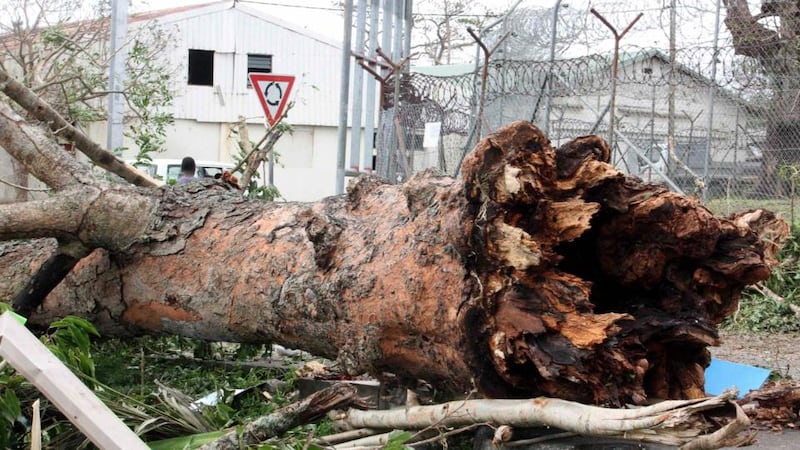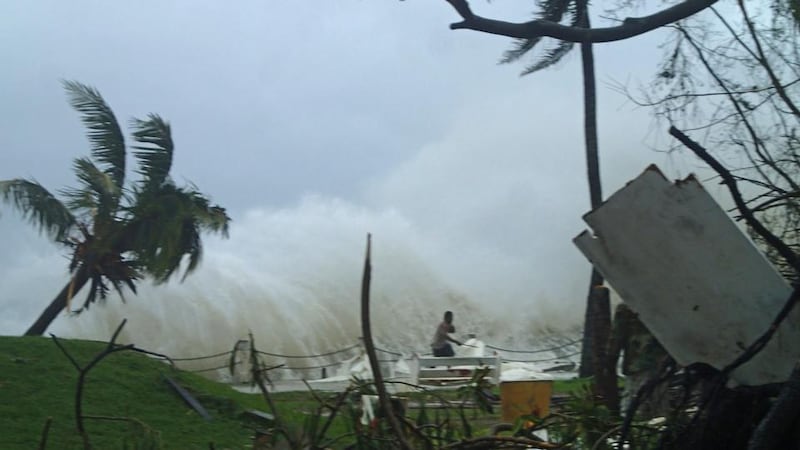The first aid teams to reach Vanuatu on Sunday encountered widespread devastation and authorities declared a state of emergency after a "monster" cyclone tore through the vulnerable Pacific island nation.
With winds of more than 300km/h (185mp/h), Cyclone Pam razed homes, smashed boats and washed away roads and bridges as it struck late on Friday and into Saturday. Aid workers described the situation as catastrophic.
The president of Vanuatu said on Sunday he fears the impact from a devastating tropical storm will be “the very, very, very worst” in isolated outer islands but damage was still being assessed.


President Baldwin Lonsdale said most houses in the capital Port Vila had been damaged or destroyed by Cyclone Pam, a category 5 storm.
"People are finding shelter where they can live for the night," he said while in Sendai, Japan, where he was attending a UN disaster recovery conference.
“The state of damage is still being assessed, we do not know exactly the extent of the damage...The number of casualties I do hope will be minor.”
Death toll
The count of confirmed deaths was at 10 with 20 people injured. But those numbers were almost certain to rise as rescuers reached the low-lying archipelago’s outlying islands.
Hannington Alatoa, head of the Vanuatu Red Cross Society, said flyovers by New Zealand and Australian relief teams showed much of the country had been "flattened."
At least half of the population, or about 130,000 people, has been affected, Mr Alatoa said in Sendai, Japan, where he and other Vanuatu officials were attending a UN conference on disaster risk reduction.
Aid workers were particularly worried about the southern island of Tanna and an official with the Australian Red Cross said an aircraft had managed to land there and confirmed “widespread destruction”.
“Virtually every building that is not concrete has been flattened,” said the official, adding two deaths had been confirmed on the island which has a population of about 29,000 and is about 200km south of the capital, Port Vila.
Sea surges
Witnesses in Port Vila described sea surges of up to eight metres and widespread flooding as the category 5 cyclone hit over the weekend.
Satellite images on Saturday showed a menacing spiral of storm covering virtually the whole archipelago as it swirled around its eye.
Residents said the storm sounded like a freight train. Port Vila was strewn with debris and looked as if a bomb had gone off.
Mr Lonsdale appealed to the world to “give a lending hand” and described the storm as being like a monster.
“Most of the buildings have been destroyed, most houses have been destroyed, schools, health facilities have been destroyed,” he told the BBC, adding that his people were “hopeless” and in a state of panic.
Formerly known as the New Hebrides, Vanuatu is sprawling cluster of 83 islands and 260,000 people, 2,000 km northeast of the Australian city of Brisbane.
It is among the world’s poorest countries and highly prone to disasters such as earthquakes, tsunamis and storms.
Aid officials said the storm was comparable in strength to Typhoon Haiyan, which hit the Philippines in 2013 and killed more than 6,000 people, and looked set to be one of the worst natural disasters the Pacific region has ever experienced.
First flight
Aid flights, including a New Zealand military Hercules aircraft carrying eight tonnes of supplies and an initial team, landed on Sunday as Port Vila’s airport partially reopened.
Australia sent two military aircraft including one with medical experts, search and rescue teams and emergency supplies while a UN team was also preparing to go in with members drawn from as far away as Europe.
Oxfam’s country manager Colin Collett van Rooyen said Vanuatu’s outlying islands were particularly vulnerable.
“We are talking about islands that are remote and really small, with none of what we would call modern infrastructure...We anticipate that that will go higher,” he said, referring to the confirmed death toll of eight.
Australia promised aus$5 million in aid, New Zealand nz$2.5 million while Britain, which jointly ruled Vanuatu with France until independence in 1980, has offered up to £2 million in assistance. The World Bank said it was exploring a swift insurance payout to the government.
“We will also be deploying humanitarian supplies to provide support for up to 5,000 people in the form of water, sanitation and shelter,” Australian foreign minister Julie Bishop told reporters in Perth.
Aurelia Balpe, regional head of the International Federation of Red Cross and Red Crescent Societies, told Reuters Vanuatu's medical system was poorly equipped to handle such a disaster.
“The country mostly relies on first aid posts and the supplies in the clinics are probably just antibiotics and pain relief.”
Late on Sunday, Pam had weakened as it moved to the southeast, and New Zealand’s northern regions were starting to feel its effects. Authorities there were warning the public to prepare for damaging winds, heavy rain and big seas.
Reuters